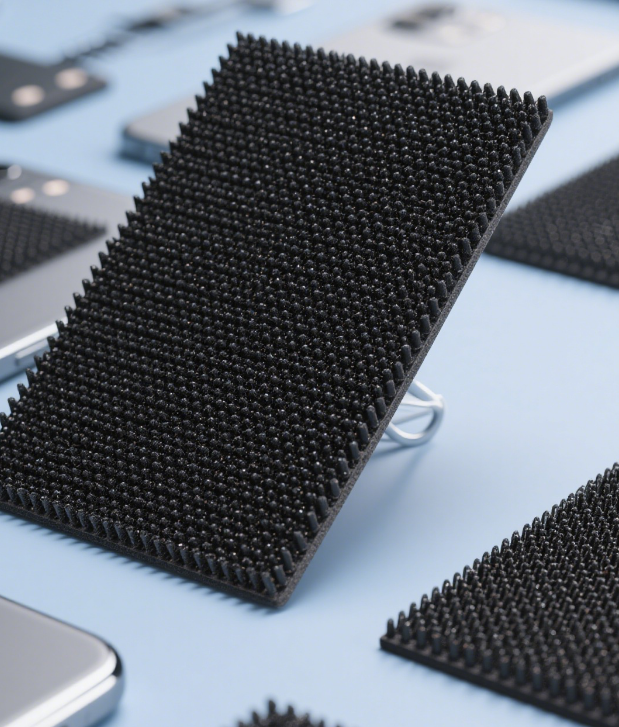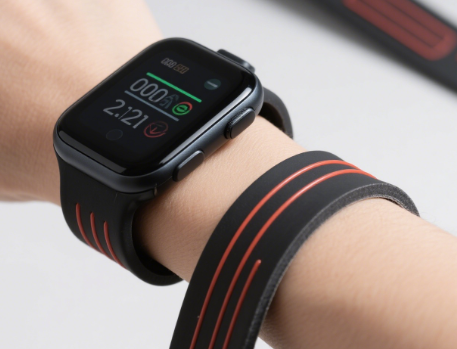ion-conductive conductive rubber
 is a new type of functional material that achieves electrical conductivity through ion migration, and its core mechanism is completely different from that of traditional electron-conductive rubber (such as conductive rubber added with metal particles or carbon black). This type of material is usually composed of a polymer matrix (such as silicone rubber, polyurethane, nitrile rubber, etc.) and an ionic conductive medium (such as ionic liquids, dissociable salts, polyether structures, etc.). Under an electric field or external stimulation, ions migrate through the channels or interfaces in the matrix to form an electric current.
is a new type of functional material that achieves electrical conductivity through ion migration, and its core mechanism is completely different from that of traditional electron-conductive rubber (such as conductive rubber added with metal particles or carbon black). This type of material is usually composed of a polymer matrix (such as silicone rubber, polyurethane, nitrile rubber, etc.) and an ionic conductive medium (such as ionic liquids, dissociable salts, polyether structures, etc.). Under an electric field or external stimulation, ions migrate through the channels or interfaces in the matrix to form an electric current.
- Core Characteristics and Technological Breakthroughs
Ionic Conduction Mechanism
Unlike electron conduction, which relies on filler contact or the tunneling effect, the electrical conductivity of ionic conductive rubber stems from the directional movement of ions. For example, in rubber modified with ionic liquids, imidazole-based or quaternary ammonium-based ionic liquids interact with polymer chains through hydrogen bonds or van der Waals forces to form a dynamic ion transport network. This mechanism enables it to exhibit unique response characteristics when humidity or temperature changes. For instance, in a humidity sensor, ambient moisture can promote ion dissociation, thereby significantly increasing the electrical conductivity.
Innovations in Material Design
Dual-network Structure: By introducing a rigid ionic cross-linking network and a flexible polymer matrix, the electrical conductivity and mechanical properties are balanced. For example, the synergistic effect of ECO rubber (epichlorohydrin rubber) and carbon powder can improve the stability of ionic conduction while maintaining ozone resistance and recovery rate.
Nano-filler Reinforcement: Nano-materials such as carbon nanotubes and graphene can serve as “highways” for ion transport. For example, in a 2025 patent of Xiamen Huatan Technology, carbon nanotubes are used to modify fluororubber, reducing the volume resistivity to below 10⁻⁵ Ω・cm.
Functionalization of Ionic Liquids: Ionic liquids can not only serve as a conductive medium but also as a plasticizer or cross-linking agent. For example, adding ionic liquids to nitrile rubber can reduce the amount of conductive filler (such as silver-plated glass powder) and increase the tensile strength to 30 MPa at the same time.
Performance Optimization Directions
High Stability: By optimizing the compatibility between the ionic liquid and the polymer, long-term cycle stability can be achieved. For example, the ionic conductive elastomer developed by the National University of Singapore still maintains 98% of the capacitance response after 10,000 cycles, with a hysteresis rate of less than 1.2%.
Wide Temperature Range Adaptability: Certain ionic liquids (such as lithium trifluoromethanesulfonate) can remain in a liquid state within the range of – 50℃ to 200℃, making them suitable for extreme environments.
Fast Response: The ion migration speed is affected by temperature and electric field strength. Some materials can complete the response within 20 ms, approaching the tactile feedback speed of human skin. - Key Application Areas
Flexible Electronics and Sensors
Pressure Sensing: The nano-conductive rubber film sensor can monitor high pressures of 0-40 MPa, with a thickness of only 1.8 mm. It has been applied to the health monitoring of bridge bearings and can evaluate structural safety through multi-point stress analysis.
Tactile Skin: The ionic gel pressure-sensitive skin developed by Shanghai Jiao Tong University can distinguish a small pressure of 35 Pa and is used for the grasping of soft robots and the tactile feedback of prosthetics. Its sensitivity is 44 times that of traditional sensors.
Environmental Monitoring: The humidity-sensitive ionic conductive rubber can detect the moisture content in the air in real-time and is used for environmental control in smart buildings or agricultural greenhouses.
Energy and Battery Technology
Solid-state Electrolyte: The rubber electrolyte developed by the Georgia Institute of Technology is embedded with succinonitrile conductive crystals, which can inhibit the growth of lithium dendrites, enabling the lithium metal battery to maintain a capacity retention rate of over 95% after 1000 cycles.
Flexible Batteries: As an electrolyte separator, ionic conductive rubber can adapt to the bending or stretching deformation of the battery, improving the battery life of wearable devices.
Smart Packaging and Medicine
Food Freshness Detection: The pH-responsive ionic conductive rubber can indicate the degree of food spoilage through color or resistance changes.
Medical Electrodes: The low-impedance ionic conductive rubber is used for electrocardiogram (ECG) monitoring, reducing skin irritation and improving signal stability.
III. Preparation Process and Challenges
Typical Preparation Methods
Solution Mixing Method: Dissolve ionic liquids or salts in an organic solvent, blend them with the rubber matrix, and then evaporate the solvent. This method is suitable for small-scale laboratory preparation.
Melt Blending Method: Melt and compound the ionic material with the rubber matrix at high temperature. The temperature needs to be strictly controlled to avoid ion decomposition.
3D Printing Technology: The National University of Singapore uses photopolymerization 3D printing technology to achieve customized manufacturing of ionic conductive elastomers with complex structures.
Technical Bottlenecks and Solutions
Low Ion Mobility: Improve the ion diffusion efficiency by introducing a porous structure or nano-channels (such as MOFs loaded with ionic liquids).
Poor Interface Compatibility: Use silane coupling agents or surface grafting techniques to improve the interface bonding between the ionic material and the polymer.
Insufficient Long-term Stability: Use hydrophobic ionic liquids or encapsulation technology to prevent moisture intrusion. For example, fluorinated ionic liquids can improve hydrolysis resistance.
- Market Prospects and Latest Developments
Market Growth Forecast
The global conductive rubber market is expected to reach $1.63 billion by 2025, and the proportion of ionic conductive products in the fields of flexible electronics and new energy is increasing year by year. As a major producer, China, driven by the demand in fields such as 5G communication and smart cars, can achieve an annual growth rate of 12%-17%.
Cutting-edge Research Progress
Self-healing Materials: The Korea Advanced Institute of Science and Technology (KAIST) has developed a self-healing ionic conductive rubber based on dynamic covalent bonds, which can repair mechanical damage and restore conductivity at room temperature.
Biocompatibility: Polyethylene glycol (PEG)-based ionic conductive rubber has been used in implantable medical devices, such as cardiac monitoring sensors.
AI Integration: Combined with machine learning algorithms, ionic conductive rubber sensors can achieve gesture recognition and motion pattern prediction, enhancing the intelligent interaction experience.
- Conclusion
Ionic conductive rubber, with its unique ion migration mechanism and flexible properties, shows great potential in fields such as flexible electronics, energy storage, and medical health. Although it faces challenges such as ion mobility and long-term stability, through innovative material design and process optimization, its performance has gradually approached the requirements for commercialization. In the future, with the development of 5G, the Internet of Things, and artificial intelligence technologies, this type of material is expected to become a core component of the next generation of intelligent systems.















